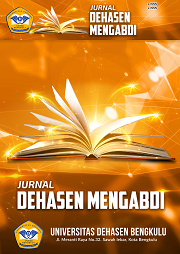Pelaksanaan Kegiatan Pembuatan Oralit Untuk Pencegahan Dehidrasi Pada Kasus Diare Di Batu Urip Lubuklinggau Utara II
Abstract
Diarrhea is still a public health problem in developing countries such as Indonesia, because morbidity and mortality are still high. The research results show that hand washing habits have a significant influence on the incidence of diarrhea. By washing hands and how to deal with it by making ORS to prevent the transmission of diarrhea, it is hoped that the public will understand the factors related to the occurrence of diarrhea, the public will understand what the causes of diarrhea are, and how to treat diarrhea itself. Most of the causes of diarrhea are pathogenic microorganisms which are spread via the fecal-oral route via contaminated food or water or are transmitted between humans through close contact (for example in child care settings). Lack of clean water, overcrowded living, poor hygiene, malnutrition and poor sanitation are the main risk factors, especially for contracting pathogenic bacterial or parasitic infections. The aim is to increase public knowledge about the causes of diarrheal diseases. Based on the results of interviews with the people of Batu Urip sub-district, the problem is the low level of public knowledge about the causes of diarrhea. To overcome the problems faced, namely implementing PHBS and washing hands properly and correctly along with the method of making ORS.
Downloads
Copyright (c) 2024 Siti Roba’ah, Rohana Rohana, Siska Avriani, Rinaldi Rinaldi, Miftahul Jannah, Liya Lugita Sari

This work is licensed under a Creative Commons Attribution-ShareAlike 4.0 International License.







